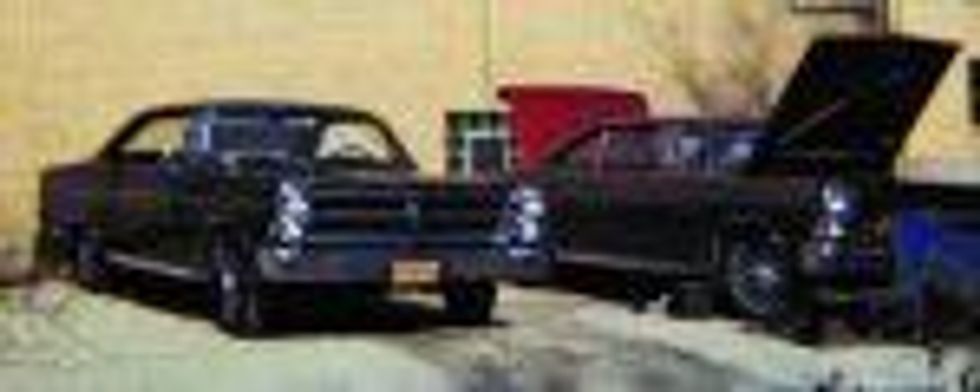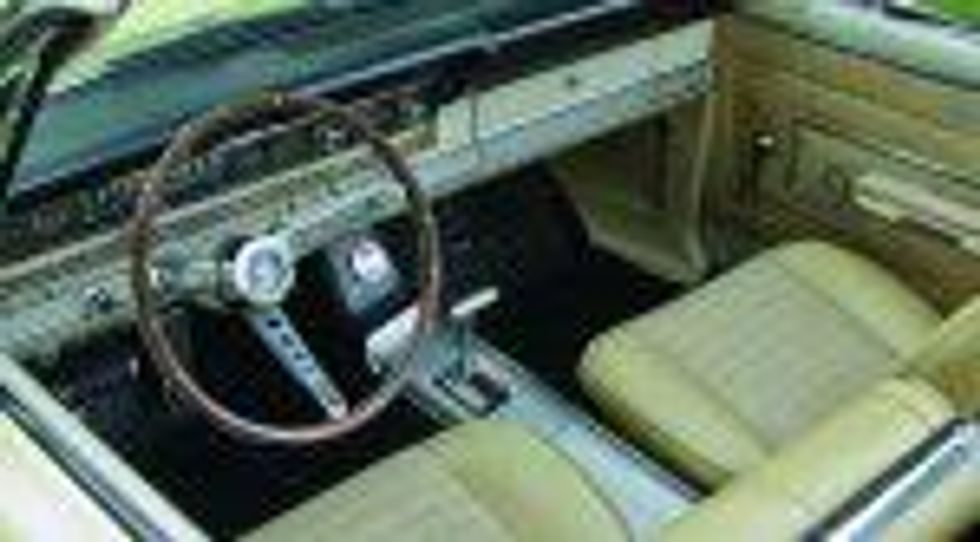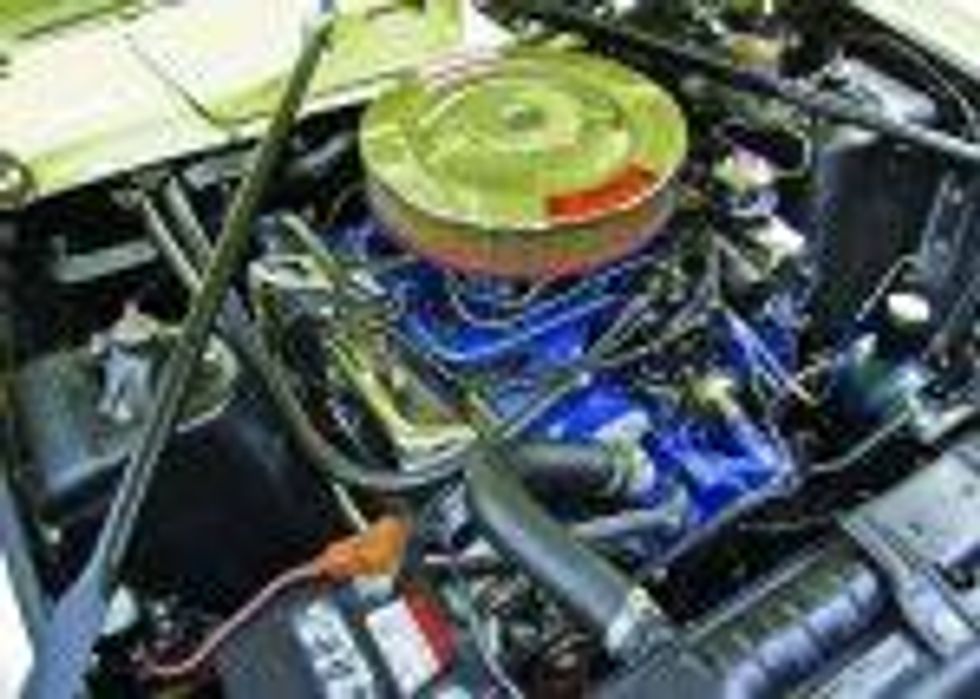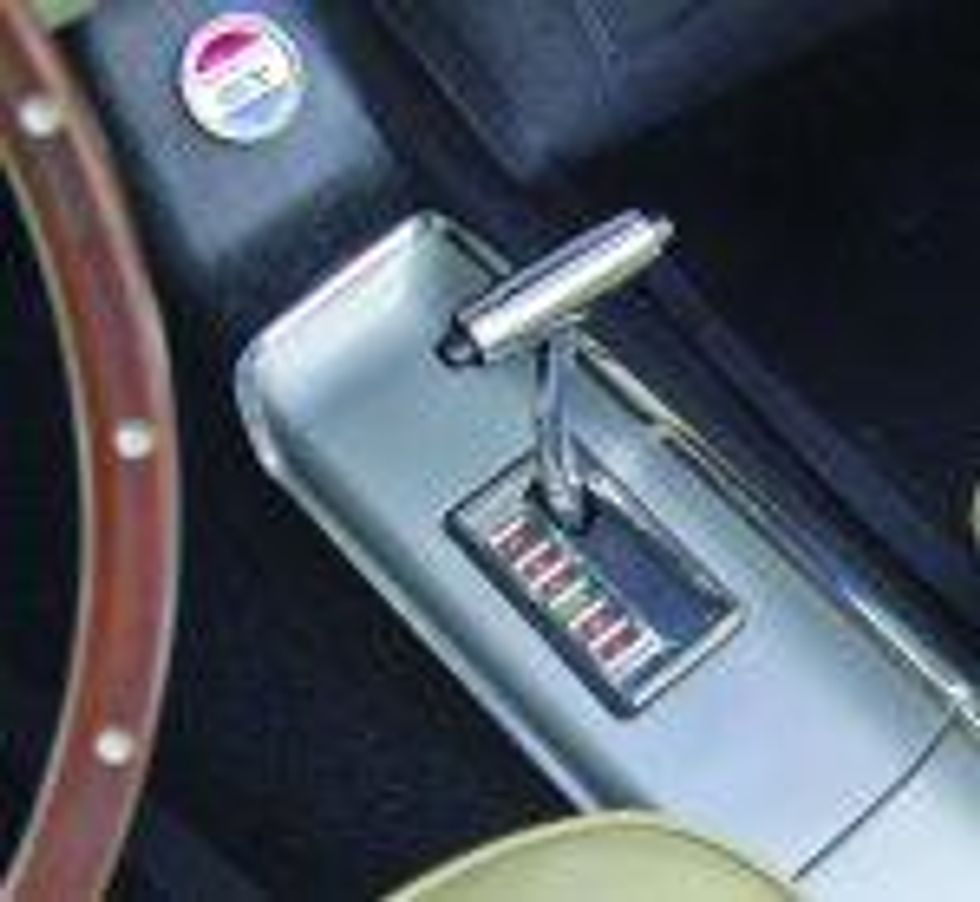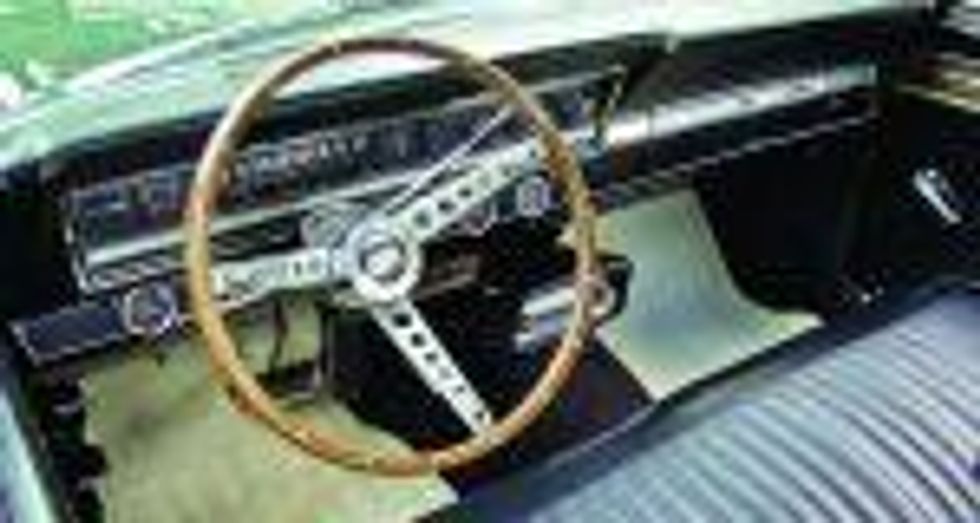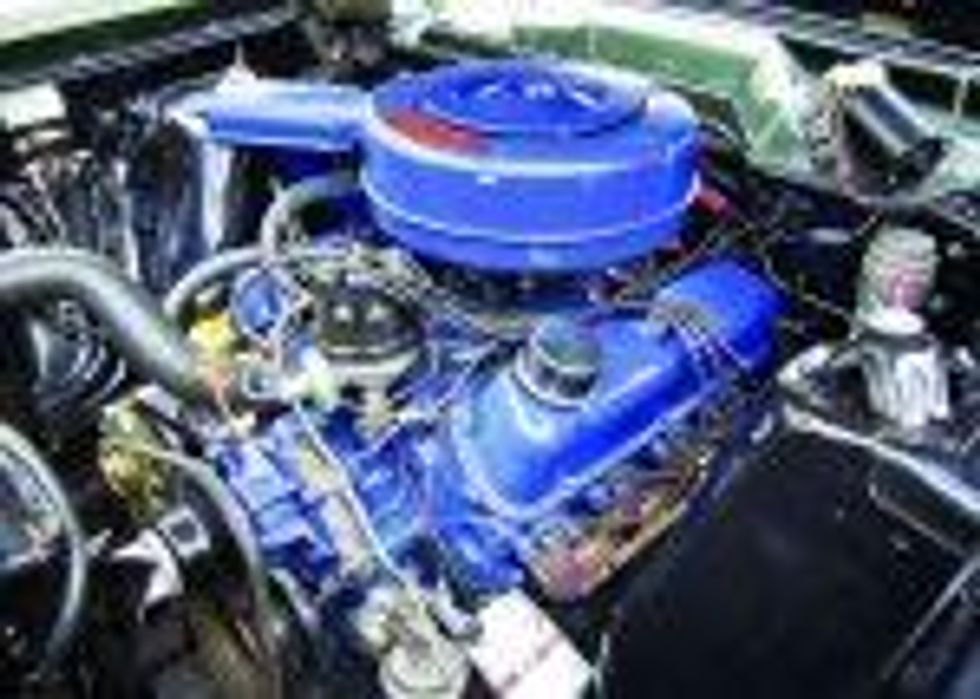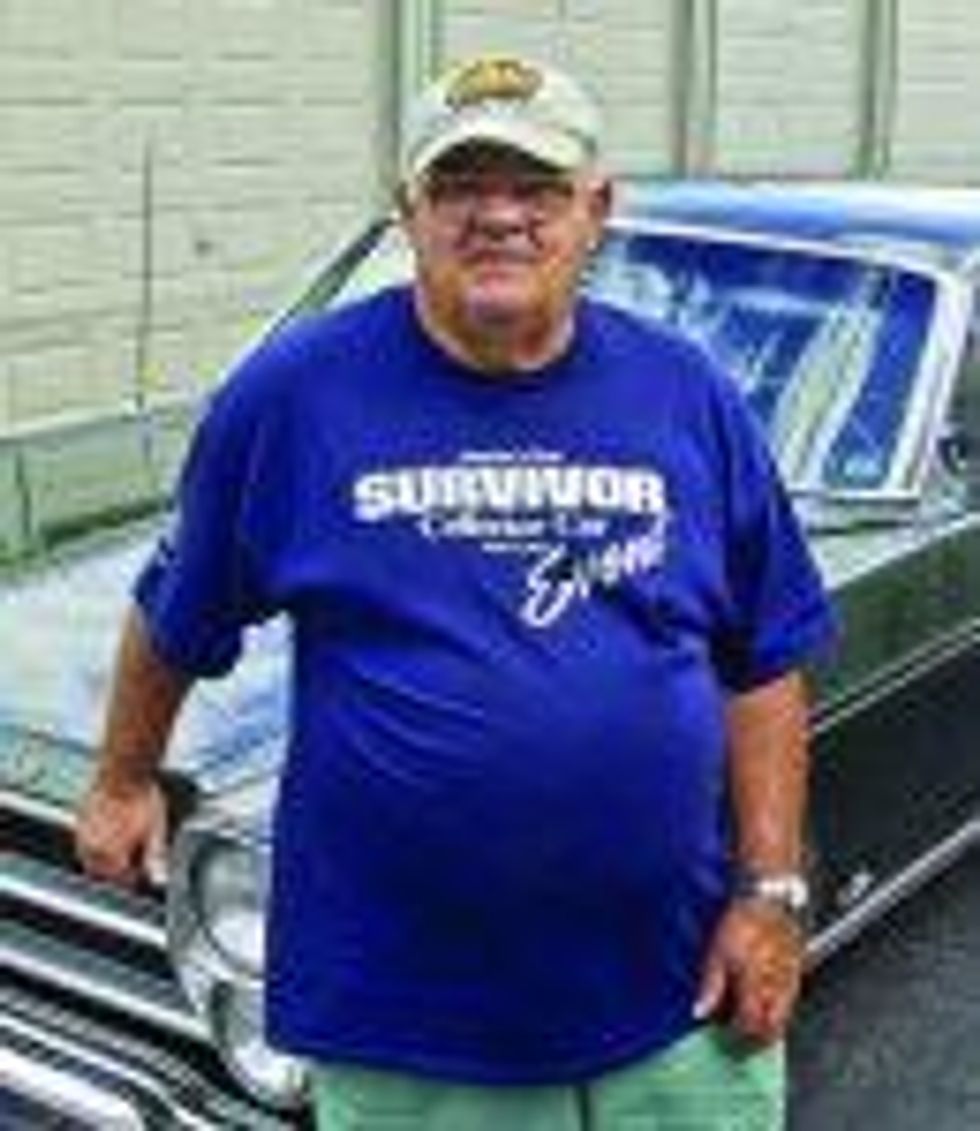
Buy
Resources
Entertainment
Magazine
Community
In This Article
Category:
Classics
An unrestored Fairlane 500 and a rotisserie-restored Fairlane GTA represent a perfect pair from Ford's 1966 intermediate line. Photos by Richard Lentinello.
Ford was on a hot streak in 1966. Mustangs were flying out of showrooms, and the Ferrari-killing GT40 won its first victory at Le Mans. The company's mid-size Fairlane sported crisp new bodies and, in its 13 variants, a wide range of trims and engines that appealed to a broad audience. For one enthusiast, the appeal was so strong that he bought one brand new and meticulously kept it for more than 45 years, and would later locate another beautifully restored example that represented the pinnacle of this model and year.
The runaway success of Pontiac's GTO showed Ford that there was something to be gained from wedging a big-block V-8 under an intermediate's hood. Dearborn countered in 1966 with the top-of-the-line Fairlane GT and GTA, cars that differed only by their transmission: GTs used a manual three-speed or Toploader four-speed, while GTAs used the console-shift C-6 "A"utomatic. The Fairlane GTA, with its powerful, exclusive 390-cu.in. V-8, bucket seats and racing stripes, caught the eye and heart of Elgin, Illinois, resident Dennis Roxworthy, and it drew him into the showroom of Conlon-Collins Ford in May 1966.
The Fairlane GT and GTA rode on a 116-inch wheelbase, and its crisp and taut new body, featuring Galaxie-style stacked quad headlamps and slender roof pillars, was available in two-door hardtop and convertible styles. Both variants shared Ford's 600-CFM Holley-carbureted S-code FE V-8, which came to its 390-cu.in. displacement by its 4.05 x 3.78-inch bore and stroke, and used 11.0-compression to make an impressive 335hp at 4,800 RPM and 427-lbs.ft. of torque at 3,200 RPM. This big-block V-8, exhaling through dual exhausts, could push the 3,493-pound GTA convertible to 60 MPH in a quick 6.9 seconds, and on to 123 MPH.
That performance potential -- and the bucket seat interior -- appealed to Dennis in 1966, but the hefty price of $3,046 before options and the need for practicality pushed him toward the mid-level Fairlane 500 hardtop. "My first wife and I were expecting our first child in 1966, when we had a 1962 Ford Galaxie Sunliner convertible and the 1959 Volkswagen that I drove to work. We felt that a convertible wasn't practical for a baby, so we'd replace it with a hardtop with an automatic transmission and a bench seat," Dennis recalls.
"I loved that new body style, and the size of the car was perfect. I originally wanted an all-black car, but she chose Ivy Green with a black interior, and we special-ordered it," Dennis remembers. The Roxworthys specified that their new Fairlane 500 be built with the two-barrel 289-cu.in. Challenger V-8 engine; Cruise-O-Matic three-speed automatic; Stereo-Sonic Tape System 8-track; pushbutton AM radio and antenna; tinted windshield; two-speed wipers; deluxe all-vinyl interior; factory pinstriping, and a passenger-door mirror. They didn't order power assists for the steering or all-drum brakes -- "When we were younger, we didn't need them, but now we do," he laughs -- and requested "poverty" hubcaps, as Dennis planned to fit the 14-inch wire wheelcovers he'd gotten from a 1964 Galaxie. The total price, with options, came to $2,960.88.
The engine that they specified for the green hardtop was the Fairlane's base V-8; even in this form, the engine had plenty of pep. Ford's small-block 289 featured a 4.00 x 2.87-inch bore and stroke and 9.3-compression, and with its two-barrel Autolite C7DF-9510-Z carburetor, it made 200hp at 4,400 RPM and 282-lbs.ft. of torque at 2,400 RPM. Mated to the column-shifted C4 Cruise-O-Matic, it moved the 3,025-pound car to 60 MPH in a very respectable sub-10.0-second time, with a 110 MPH top speed.
"We almost didn't get the car," he recalls. "I didn't want a 1967 because I didn't like the safety-influenced changes Ford had made. They had a hard time getting the order through, and this was one of the last 1966 models built. The car finally arrived on July 19, and the dealer called to tell me it was in. I went over right away, and it was still on the carrier -- it hadn't been unloaded yet, and the antenna and poverty caps were still in the trunk. I asked them to leave the hubcaps in the trunk, and to save all of the tags and paperwork that came on the car. We picked it up the next day, after it had been prepped and washed. It was a thrill."
The new Fairlane 500 hardtop became a grocery-getter for Dennis's wife, who became a stay-at-home mother when their son was born that November; it was rigorously maintained and garaged, and wasn't driven in bad weather. Still, the family made some long trips in it, taking Route 66 from Illinois to San Francisco in 1968, and driving it to the new Walt Disney World in Florida in 1971.
The car saw little use after the early 1980s, which explains the mere 47,600 miles on its odometer today. It hasn't asked much of its owner, either: "We actually had the hood repainted by the dealer when it was new, because the primer was visible in spots," Dennis says. "And the dealer replaced the water pump under warranty when the car was a few months old. Mechanically, it's had one change of hoses, one change of brake shoes and one rear-wheel cylinder rebuild. I replaced the exhaust system in 1982 -- it was full of pinholes -- and the heater core two years ago. While the spark plugs, rotor and points have been replaced, the plug wires and distributor cap are original."
The fine condition of this beloved Ivy Green hardtop, coupled with Dennis's precise record-keeping, has meant that it was a prime candidate for the SURVIVOR Collector Car event, famous for its fanatical focus on finely preserved, unrestored vehicles. Indeed, Dennis exhibited the green Fairlane 500 in 2009, and it was awarded SURVIVOR Limited and Original Owner certifications.
But, as HCC editor and SURVIVOR event judge Richard Lentinello discovered, the 500 hardtop isn't Dennis's only beautiful 1966 Fairlane; let's get back to the Springtime Yellow GTA convertible on these pages. "I bought this car from Duffy's Collectible Cars in Cedar Rapids, Iowa. They knew that I was looking for a mint 1966 GT or GTA convertible, and they called me as soon as they got this one," he recalls.
"I've always wanted one of these cars. This one was given a rotisserie restoration by the son of the original owner, and they did it factory-correct, with the proper red oxide primer overspray on the floor pan and duplicated factory crayon marks. It was always an Iowa car and had never been driven in winter, so it was a great base from which to work. It was so nice that I made a deal on the spot."
Dennis knew of the 1966 Fairlane GTA convertible's rarity -- just 4,327 were built -- because he'd been looking for a matching-numbers, date-coded example in excellent condition for some time. "I've been attending shows and classic car auctions for years, and you just don't see these cars. If I wanted a 1967 GTO, I could have my pick; they're easy to find, but GTs and GTAs are few and far between."
In addition to the bucket seats that he'd long wanted, his GTA sported an impressive list of optional equipment: power steering and power drum brakes; power convertible top; limited-slip differential; chrome styled steel wheels and red-line tires; a pushbutton AM radio with antenna; deluxe steering wheel; a tinted windshield and more. This GTA had everything save for air conditioning, and its $3,782 1966 sticker price would have made an uncomfortable monthly payment for a newly married couple with a family on the way.
His two sons fully grown, Dennis can now enjoy having his cake (500) and eating it too (GTA), experiencing a wide spectrum of the Fairlane's performance envelope. "Both cars have a lot of low-end punch," he says. "The 500 will squat back on ya, and take off, but the GTA is scary fast, and it pushes you back into the seat. The 500's 7.35-14 tires, which I ordered in place of the stock 6.95-14s, look like donuts compared to the F70-14 Wide Ovals on the GTA. The cars also have different suspension setups; the convertible has larger A-arms and the heavy-duty 9-inch rear end, and its C6 automatic can be shifted manually. The 500 rides really smoothly, without a rattle, and leans a bit in the corners, while the convertible has a bit of cowl shake, and around a corner, it stays flat."
One common aspect of these Fairlanes is their brakes: "You can tell that the yellow car is heavier, with the big-block engine, and while they ride and drive really well, you have to give both room to stop. The 500's manual drums fade less than the GTA's because it doesn't have the heavy big-block V-8; the GTA's power drums will continue to roll on you, unlike some cars with power brakes that come to a screeching halt when you stomp on it. It feels like a muscle car -- the convertible's stiffer, faster and handles better around corners."
Dennis maintains both Fairlanes' show-ready condition by following a careful regimen. "I change both cars' oil and oil filters every year. The antifreeze is changed every two years. I add Marvel Mystery Oil to the 500's 10W-30, and to its gas, because it keeps the valves free. I wax their paint and chrome with Mothers paste wax. I like Lexol vinyl treatment for the interior and rubber seals, and I use Mothers Instant Detailer in the engine bay."
The performance variants of this generation of Ford's mid-sizer have their own dedicated bunch of fans, but don't enjoy the widespread popularity of period GM or Chrysler intermediates, and accordingly, their values aren't as high. West Hills, California, resident Mark VanCleve is the Fairlane Club of America's 1966-'67 specialist, being an unrestored-class judge at FCA concours events as well as moderating the 1966-'67 section of the FCA message board. The owner of five Fairlanes of this vintage, he pays close attention to their values and place in the old-car hobby: "Fairlanes are in their infancy as true collectibles, and they lag behind due to the tremendous popularity of the Mustang.
"Although these cars share common mechanical and suspension components, the Mustang remains sportier and more valuable, while the Fairlane was always Ford's bread and butter family car. Fairlanes didn't get a lot of fanfare, outside of the GT and GTA series. In the decades after they were new, a lot of them were cannibalized for Mustang projects. Now, Blue Oval guys who don't want or can't afford a Mustang, are turning to Fairlanes as economical alternatives.
"Fairlanes, Cyclones and Comets can still be picked up for reasonable prices, and aside from fully restored 427 cars, you'll generally find their high values around $35,000, with restorable cars going for as little as $1,000," Mark says. "Reproduction parts availability, an issue in the past, is starting to improve, and some vendors now carry parts that you used to have to scour wrecking yards for."
The book values of Fords don't mean much to Dennis, because he considers them heirlooms; "These cars will be passed on to my two boys; I'm never going to sell them. The green one, in particular, is a part of me. I've told them that I'll give them the cars when I can't do anything with them anymore. I'm hoping that my grandkids will drive them someday."
This article originally appeared in the March, 2012 issue of Hemmings Classic Car.
Recent
For 1958, all-new styling at every General Motors passenger-car division ushered in big changes, just as the corporation was celebrating its 50th anniversary. It was also the final year with Harley Earl at the helm of GM design. Though the new models were longer and lower in proportion than in previous years, Earl’s signature use of excessive chrome remained unabated. That brightwork continued a trend that had dominated automotive design throughout the Fifties. For 1958, it worked seamlessly with those new designs that presented a broad departure from previous years.
Currently listed on Hemmings Auctions are a pair of faithfully restored hardtop coupes from the GM catalog from that momentous year. With wide chrome grilles surrounding four headlamps and copious brightwork including side trim the length of the body, this 1958 Chevrolet Impala Sport Coupe and 1958 Pontiac Bonneville Sport Coupe both handsomely display the heavily Earl-influenced styling that made headlines for GM.
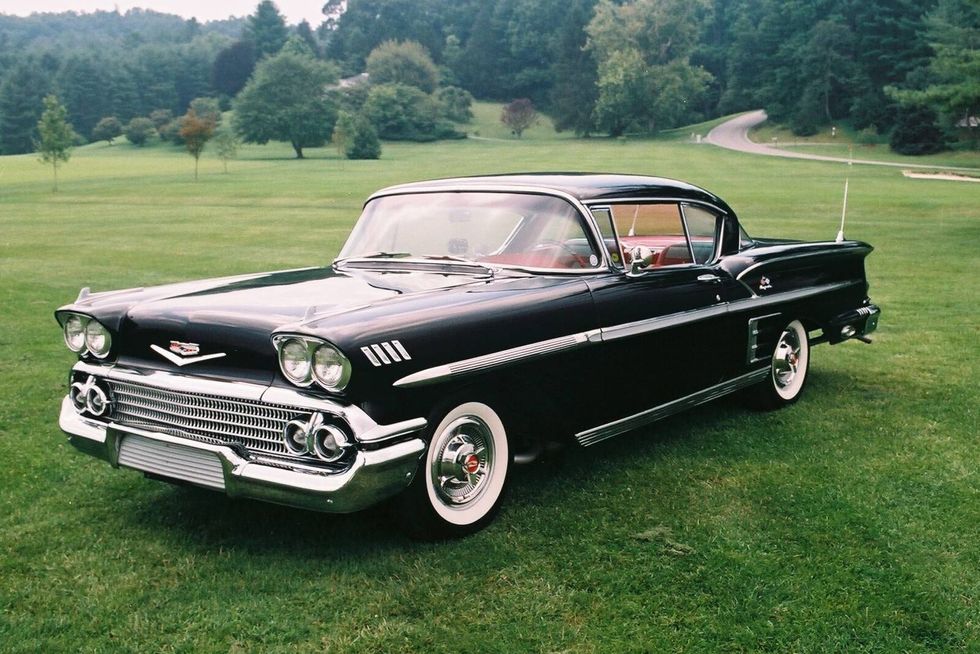
1958 Pontiac Bonneville Sport Coupe
While GM made general announcements and events around its 50th anniversary for 1958, only Pontiac incorporated the occasion into its advertising. It mattered little that the first Pontiac rolled off the assembly line in 1926 as sub-brand of Oakland. Laid out in large letters in its brochure, Pontiac’s advertising theme for 1958 carried the tagline “The boldest advance in fifty years,” also declaring “A new kind of cars is born!” Previously introduced as a well-optioned convertible version of the Star Chief in 1957, the standalone Bonneville arrived for 1958.
Promising “the first true union of sport car action with town car luxury,” the Bonneville was only produced as a pillarless hardtop Sport Coupe or a drop-top Sport Convertible for 1958. As “a modern ultimate for the man who loves cars…this steel-muscled road machine,” the Bonneville featured a 370-cu.in. V8 engine with a four-barrel carburetor and 10:1 compression as standard equipment. An optional Tri-Power setup with triple two-barrel carburetors was given the “Tempest 395” moniker for its 395 lb-ft torque rating.

As the late 1950s was peak Jet Age, aeronautical and rocket themes pervade the details of the Bonneville. The leading edge of the scalloped rear quarter panels featured a very rocket-like piece of chrome trim that extended to a point at the front of the car. On top of each front fender, just before the headlamps, sat additional chrome-plated pieces that resembled delta-wing jets with appendages that lead into creases atop the fenders like contrails from jet engines.
Finished in Burma Green with Calypso Green accents, this 1958 Bonneville Sport Coupe, one of 9,144 produced, appears to have been restored some years ago, with a fit and finish that looks to be holding up. It is equipped with the Tri-Power 370 and a four-speed Super Hydra-Matic transmission. It is additionally fitted with power windows and power brakes, along with the rare Trans-Portable radio unit that can be removed and used as a portable radio with its built-in speaker and ability to run off batteries. The seller notes no problems with the drivetrain and asserts that the transmission shifts well.

1958 Chevrolet Impala Sport Coupe
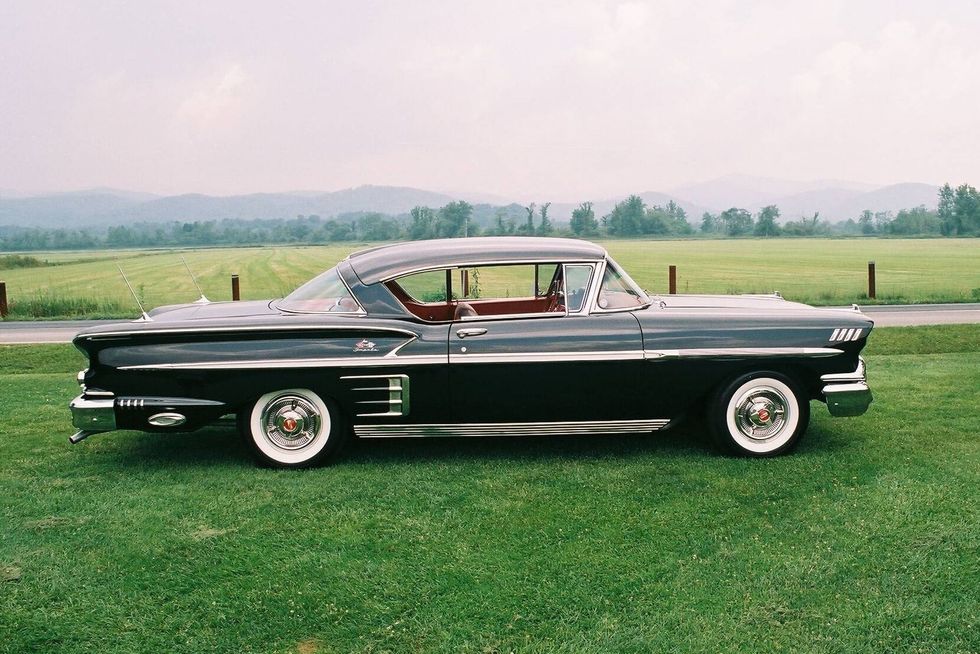
Chevrolet didn’t revel in the golden jubilee news that Pontiac touted, but its advertising in 1958 suggested that its redesigned models were “Almost too new to be true!” The ad copy also promised that “You’ll like being looked at in your beautiful ’58 Chevrolet.” Longer, lower and wider than the famous “Tri-Five” models that preceded it, the Chevrolet models somewhat mirrored what was going on at Pontiac, but with a rear-end treatment that seemed to show the previous year’s tall tailfins flopped over somewhat. In magazines ads, the words accompanying the first-year Impala Sport Coupe suggested “This sleek styles-setter promises action, gaiety, glamor—and it keeps its promises beautifully.”
Like the Bonneville nameplate, the first Chevrolet to wear the Impala badge arrived in 1958. Chevy also introduced its first big-block V8, the so-called “W” engine. For 1958, Chevrolet dubbed this 348-cu.in. engine the Turbo-Thrust V8 when equipped with a four-barrel carburetor and Super Turbo-Thrust when fitted with Tri-Power triple carburetion. Though it lacked the aviation/space themes of the Bonneville’s styling, the similarly proportioned Impala was also festooned with plenty of brightwork, from the wide grille to side spears that ran nearly from the taillights to the headlamps. Pound-for-pound, the massive wraparound bumpers probably contained the highest amount of chrome on the car.
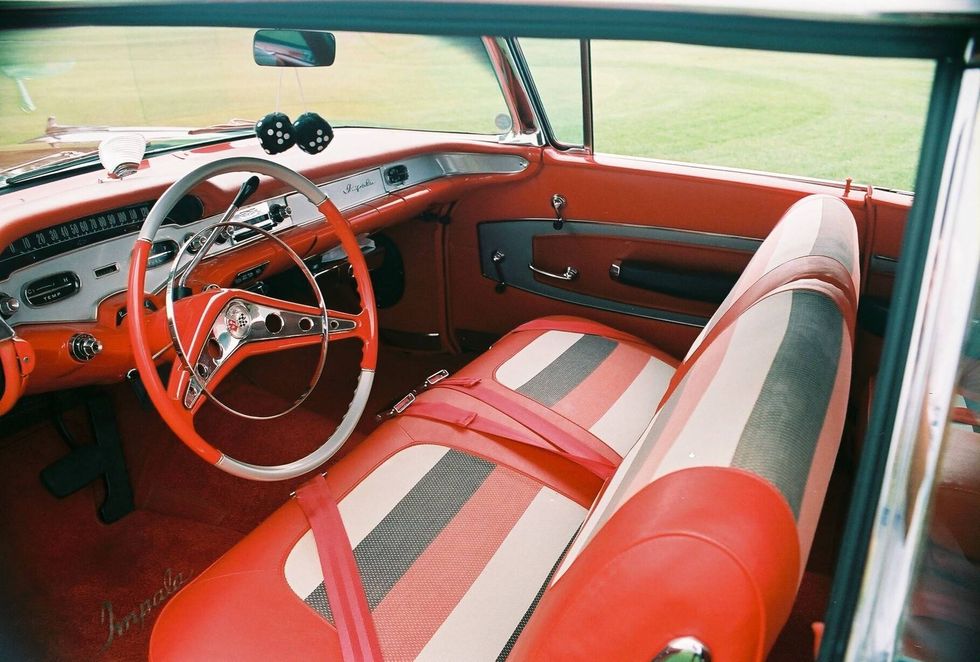
Finished in Onyx Black with a bold Rio Red-dominated interior, this 1958 Chevrolet Impala Sport Coupe now on Hemmings Auctions features a long-term restoration that spanned the 1990s. Completed in 2001, it appears to be holding up well. The photos of the very clean undercarriage that accompany the listing tell a story that the car has been taken care since that redo. This example is fitted with the four-barrel 348 that was rated at 250 horsepower when new. Power reaches the rear axle via a two-speed Powerglide automatic transmission.
GM made some distinct design changes for 1958. With plenty of models across five passenger-car divisions, we are fortunate to have options in the collector car hobby when it comes to these chrome-laden machines. Which of these ’58 hardtop coupes would you like to cruise in?
Head on over to Hemmings Auctions to take a look and let us know.
Keep reading...Show Less
Photo: Terry McGean
The revived and revised Hemmings Cruise-Ins entered their third year in downtown Bennington, Vermont, on Thursday, May 17, 2024. Moderate temperatures and mostly sunny skies gave cruisers and spectators a wonderful evening of strolling among the 119 special-interest vehicles in attendance.
Hemmings Cruise Nights are always a fascinating mix of classics, muscle cars, hot rods, trucks, vans, and the downright unusual. Three of last night’s participants also took home a trophy: One for Favorite Car, one for Favorite Truck, and our Harlan Kip Memorial Best in Show award, for the vehicle of any type that makes the best impression overall on our judges. See those winners in the list below.
The season’s next cruise night is scheduled for Thursday, June 20, 2024. Main Street parking for cruisers begins at 5:00 p.m. and the street re-opens to traffic at 8:00p.m. For directions and other information, visit https://www.hemmings.com/event/cruise-ins.

Photo: Terry McGean
When we first spotted the '70 Cutlass SX owned by Alan and Isabelle Hadley, we didn't realize how unusual it was. The SX was an upgrade package intended to add luxury to the Cutlass, and came with a 455 engine, but usually with a two-barrel carb. However, this one—according to the build sheet Alan showed us—was optioned further with the W32 performance version of the 455 along with FE2 Rally Suspension, 3.08 Positraction rear axle, console with Hurst Dual-Gate shifter, extra-cost Rally Red paint, and Super Stock II wheels. The result was essentially a thinly veiled 4-4-2. -Terry McGean
Photo: Dave Conwill
<p>This 1974 Volkswagen Type 2 van belongs to Ken Galo of North Clarendon, Vermont. Ken had a repair shop for years and he is recently retired. He purchased this van from a former customer, and he had done considerable maintenance on it over the ten years before he bought it. That customer was the third owner and had purchased it from Oklahoma. Ken was drawn to it because of its rust-free condition. He says he regularly takes it out for ice cream and local shows. He puts a thousand miles a year on it, and he drove it down from near Rutland. -<em>Dave Conwill </em></p>




Photo: Mark J. McCourt
<p>It was really fun to see the beautifully preserved 1991 Subaru XT6 belonging to West Rutland, Vermont's John Ellis. This wedgy sports coupe, with its colorful upholstery and two-spoke steering wheel, dates from the era before Subaru was a mainstream brand, but it carries two things any modern Subaru owner would recognize: all-wheel drive and a horizontally opposed engine. -<em>Mark J. McCourt </em></p>



Photo: Terry McGean
Victor St. Peter of Shaftsbury, Vermont (right) talks bikes with Hemmings' Junior Nevison while the two look over the 1974 Honda 750 Four Victor recently acquired from its original owner. The Honda has 9,400 original miles and runs great according to Victor, who says he'll be rolling the odometer up a bit further this summer. -Terry McGean
Photo: Dave Conwill
<p>A 1955 Buick Special is an unusual site these days, but particularly interesting. Was this one brought down from Schaghticoke, New York, by owner Tom Plasse. He's owned the Buick for 9 or 10 years now. The paint was already done when he purchased it but he's done all of the other work including custom pinstriping and seat covers in the interior, plus some tweaks to the 264-cu.in. Nailhead V-8 to get it run more to his satisfaction. -<em>Dave Conwill</em></p>



Photo: Dave Conwill
<p>Up from Williamstown Massachusetts was long-time friend of Hemmings Don Rancatti. Don often brings a Nash Ambassador to our shows, but this evening had a 1949 Cadillac fastback which he's owned since the late 1990s. originally sold new in New York City, the car seems to have spent many years in Texas before moving to Illinois and finally to Massachusetts. Don says the Cadillac was not rusted at all but needed paint. He said the bodywork was done extremely well by some unknown previous craftsman. The headliner; 160-hp, 331-cu.in. V-8 engine; and Hydra-Matic transmission all remain original. Don says the car drives nice even though it does not have power steering. -<em>Dave Conwill </em></p>



Photo: Mark J. McCourt
<p>We had a couple of turbocharged Swedish visitors in Bennington, built 30 years apart. The 1978 Saab 99 with the 2.0-liter four and four-speed manual, and the wild wrap covering its Cardinal Red paint, belongs to Boston resident Syd Cummings; the 2008 Saab 9-3 Aero convertible wearing a 2012 Griffin grille, behind which sits a 2.8-liter V-6 and 6-speed automatic, came all the way from Michigan with Case Van Kempen at the wheel. -<em>Mark J. McCourt </em></p>



Photo: Terry McGean
This '55 Chrysler 300 looked great, but concealed a surprise in that it was mounted over a 2018 Dodge Challenger SRT Hellcat--not just the drivetrain, but then entire chassis. It belongs to Paul White, who also owns the '49 Chevy behind it. Paul (far right) builds hot rods at his shop, Back Bay Customs in Portland, Maine, with help from friends Stanley Stevens (center) and Bill Richards. The Chrysler made the trip to Vermont under its own power—all 707 hp— for our kick-off Cruise Night, and later received Hemmings' Harlan Kip Best in Show award for the night. -Terry McGean
Photo: Dave Conwill
<p>We've yet to meet everyone with a Ford luxury car of the so-called Malaise Era who hasn't absolutely loved it. Jerry Wawrzyniak of Corinth, New York, was no exception. He has had this 1978 Lincoln Continental with Town Car trim for 7 years now. It still sports its original paint, interior and drivetrain but Jerry had the vinyl top and padding restored by a shop in Albany after five other shops had declined to do the work. He says the car 19-foot, 4-inch car rides "unbelievably" since it has a wheelbase "like a Greyhound bus." He says it's easy to maintain because the entire drivetrain is all-Ford. It's a regular at dinner date nights, airport pickups, train station drop offs, proms weddings and other celebrations. Jerry says he drives it every other day in nice weather. -<em>Dave Conwill </em></p>





Photo: Terry McGean
Mark and Lisa Shea of Bennington are regular Cruise Night attendees, each often bringing a vehicle to display. On this night, Mark brought out his '65 GTO, looking sharp with its Tri-Power air cleaners gleaming in the setting sunlight, along with period upgrades like Hurst mags and white-letter Wide Oval tires. -Terry McGean
Photo: Dave Conwill
<p>Does anyone know Gene Charney of Wilmington, Vermont? We missed him, but he's apparently owned this 1974 Ford F-250 Custom Cab Styleside since new. It's got the 375-hp, 460-cu.in. 4-V "regular fuel" V-8 and has racked up a mere 133,000 miles over its lifetime. It's clear Gene takes pride in his truck and we'd love to know more about it. – <em>Dave Conwill </em></p>




Photo: Mark J. McCourt
<p>It was great to see our friend Jerry Mattison's incredibly restored, crowd-pleasing 1956 Dodge C3 Power Wagon, which starred in a <a href="https://www.hemmings.com/stories/restoration-1956-dodge-power-wagon/" target="_blank" rel="noopener noreferrer">2022 Hemmings Motor News feature</a>. Jerry drove the Dodge (slowly!) to Bennington from his home in nearby Glastenbury. While this truck has gone further afield to win prestigious concours awards since its four-year, ground-up restoration was completed, it has always been local to southwestern Vermont. -<em>Mark J. McCourt</em></p>


Photo: Terry McGean
<p><strong></strong>A few years ago, David Townsend bought a '64 Jaguar XKE online and had it shipped from California to his home in Scotia, New York, with the assurance that it was an very solid car that just had a Chevy drivetrain transplant. However, as soon as it came off the transport truck, it was evident that the Jag had many issues. "All the Jag stuff was gone, so I figured the only way to make it right was to do it over my way," David told us. So, he completely rebuilt the car, building a frame for it and mounting a Toyota 2JZ-GTE inline six. The twin-turbo engine is well known among fans of Japanese performance cars for its power potential, but still makes the right sounds for a vintage E-Type. <em>-Terry McGean</em></p>


Photo: Dave Conwill
<p>The Ford F-series began with the single-digit F's of 1948-'52. This 1950 Ford F1 is a beautiful example of the half-ton model. It's powered by Ford's legendary 239-cu.in. flathead V-8. It belongs to Randall Kavett of Orwell, Vermont. Unfortunately, Randall wasn't around to tell us more about the story of this patinaed beauty, but it appeared to be a great mix of restored surfaces and preserved original. -<em>Dave Conwill </em></p>




Photo: Terry McGean
Ken Townsend has been working on his '49 Ford F1 pickup for the past four years, rebuilding it into an updated cruiser ready to go wherever. To that end, he mounted a Mustang II front suspension, a Ford 9-inch rear axle, and used a GM 4.8-liter Gen III V-8 engine along with its 4L60E four-speed automatic. "I was able to buy the engine for $400—it runs like a top!" Ken said when asked what made him choose the littlest LS. That color is Light Tundra Metallic, from an '03 Lincoln. Ken told us he and his friends finished the Ford project just hours before leaving for our Cruise Night, and on its first outing, the Ford garnered our Editor's Choice: Favorite Truck award for the evening. -Terry McGean
Photo: Mark J. McCourt
<p>Our "Editor's Choice: Favorite Car" award winner of the May 16 Cruise-In is this incredible 1986 Lincoln Mark VII belonging to Elijah Kaznozki, who along with his father, Derek, drove the Mark all the way to Vermont this morning from their home in Martinsburg, West Virginia -a seven-hour trip- to attend this event. The head-turning American luxury coupe has a mere 60,000 miles on the odometer and it's been a father-son refurbishment project since they purchased it in 2020. "It was in good condition, but a bit tired," Elijah says. "We've been working on it, tuning up the 5.0-liter V-8 and troubleshooting any issues that arise. We refinished the alloy wheels, and my dad restored the steering wheel." The Kaznozkis tell us this trip was the first time they've driven the car more than two hours from home, something they've long wanted to do, and it was an entirely pleasurable experience. "It's not an LSC, so it doesn't have a firm suspension... you'll never find anything today that rides so nicely," Elijah says with a smile. -<em>Mark J. McCourt </em></p>





Keep reading...Show Less


